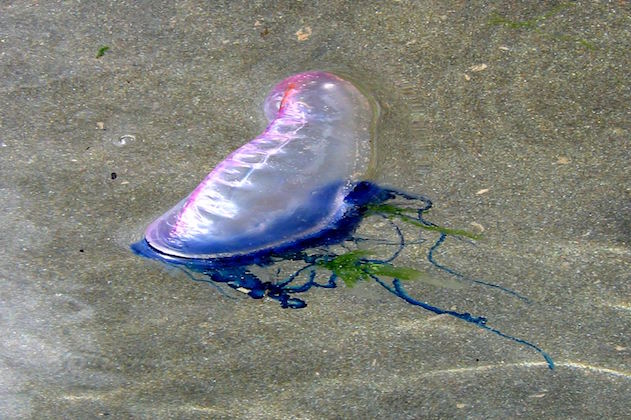The Marine Conservation Society issue advice on the potentially fatal Portuguese Man of War that have washed up recently on UK beaches.
Immediate release from MCS – pic Peter Soper.
Stinging Portuguese Man-of-War wash up on UK shores
Marine charity warns beach visitors not to touch this bizarre stinging creature that’s not a single animal but a floating colony!
The Marine Conservation Society (MCS) have received reports of several Portuguese Men-of-War washing up on beaches in Cornwall and Scilly Isles just weeks after authorities in Ireland warned local beach goers about a spate of recent strandings of this potentially dangerous floating sea creature.
Stings can be exceptionally painful and in extreme cases fatal.
MCS says the Portuguese Man-of-War (Physalia physalis) are only occasionally reported in UK waters with the last significant UK strandings of the species occurring in 2009 and 2012.
“We don’t receive reports of Portuguese Man-of-War every year, but when we do they can turn up in big numbers, usually around about this time of year”, said Dr Peter Richardson, Head of the MCS Biodiversity Programme, “In the last couple of weeks we’ve received several confirmed reports of Portuguese Man of War stranded on beaches around Cornwall and the Scilly Isles. With the earlier strandings in Ireland, these recent sightings could herald the arrival of more of the creatures as they get blown in from the Atlantic.”
The Portuguese Man-of-War isn’t a jellyfish but is closely related, and consists of a floating colony of hydrozoans – lots of really tiny marine organisms living together and behaving collectively as one animal. A Cornish pasty-shaped, transparent purple float is visible on the water’s surface whilst the blue, tentacle-like ‘fishing polyps’ that hang below the float can be tens of meters in length.
“It’s the tentacle-like polyps that can give an agonising and potentially lethal sting,” said Dr Richardson, “Because a stranded Portuguese Man of War looks a bit like a deflating purple balloon with blue ribbons attached, children will find it fascinating. So, if you’re visiting a Cornish beach this weekend it’s well worth making sure you know what these animals look like and that no one picks them up. We’d like people to report any sightings of Portuguese Man Of War to our website so we get a better idea of the extent of the strandings.“
One of the animals was found this weekend at Portheras Cove, near Morvah, Cornwall by volunteers of the Friends of Portheras Cove environmental group. Delia Webb from the group says it was found during a beach clean, lying among the plastic debris that had blown in on the high tide; “We find all sorts of strange and unusual items at our tiny Cornish cove, and we have had strandings of Portuguese Man of War before. They look amazingly beautiful, with hints of pink and blue, but thankfully we were aware of the potential danger lying beneath, and knew not to poke or prod it, just report the sighting to the MCS.”
If you spot a Portuguese Man-of-War then report the sighting immediately, ideally with a picture, to www.mcsuk.org, where a Jellyfish ID Guide, which includes the Portuguese Man O War, can also be downloaded.
The Marine Conservation Society (MCS) is the UK charity dedicated to the protection of our seas, shores and wildlife. MCS campaigns for clean seas and beaches, sustainable fisheries, and protection of marine life. Through education, community involvement and collaboration, MCS raises awareness of the many threats that face our seas and promotes individual, industry and government action to protect the marine environment. MCS provides information and guidance on many aspects of marine conservation and produces the annual Good Beach Guide (www.goodbeachguide.co.uk), the Good Fish Guide and www.fishonline.org relating to sustainable seafood, as well as promoting public participation in volunteer projects such as MCS Beachwatch Big Weekend (www.mcsuk.org/beachwatch) and Basking Shark Watch www.mcsuk.org.
Jellyfish in UK waters: The moon jellyfish (Aurelia aurita) is the most widespread species, occurring all around the UK coast from May, as does the blue jellyfish (Cyanea lamarkii). In contrast, the giant but harmless barrel jellyfish (Rhizostoma octopus), which can grow up to 1 metre in diameter and weigh up to 40kgs, is largely limited to the Irish Sea and adjacent waters to the north, but has occurred in huge numbers in recent years along the south coast of England. It occurs year round, even in winter, but blooms tend to start in March. The lion’s mane jellyfish (Cyanea capillata) has the most powerful and painful sting of the UK species. It blooms during the summer but is rarely seen south of the Irish Sea (west coast), or south of Northumberland (east coast), with most reports coming from Scottish waters. The Compass jellyfish (Chrysaora hysoscella), with its bizarre compass-like markings, is found throughout the UK coast. Mauve stingers (Pelagia noctiluca) are occasionally recorded from the southwest in early spring and late Autumn/Winter. The first 9 years of jellyfish survey data was analysed in collaboration with the University of Exeter in 2013 seehttp://www.seaturtle.org/PDF/PikesleySK_2014_JMarBiolAssUK.pdf

